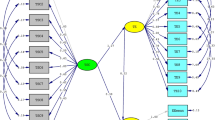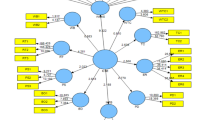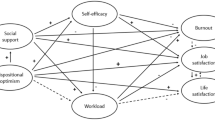Abstract
This study investigated the association between perceived self-efficacy and burnout among teachers. Self-efficacy has been defined operationally based on a three-dimensional conceptualization: task, relations and organization. Efficacy variables were three classroom efficacy factors: instruction (task), discipline control (task), and consideration (relations), and two organizational efficacy factors: inclusion (task) and influence (relations). Burnout was measured as both a three-dimensional measure comprised of exhaustion, unaccomplishment and depersonalization, and as a single dimension (a composite score including all three dimensions). A sample of 322 Israeli teachers completed a self-report questionnaire. Multiple analysis of variance (MANOVA) and multiple regression analysis were used. It was found that perceived sense of self-efficacy was inversely correlated with perceived burnout: the lower the sense of self-efficacy, the higher the perceived burnout. The salience of organizational influence efficacy, and consideration efficacy (both are relations efficacies) were noted as important variables in predicting exhaustion, unaccomplishment and depersonalization. Task efficacies (e.g., instruction, discipline control, and inclusion) had no significant or meaningful weight in statistically predicting burnout beyond the relations efficacies. The importance of the organizational self-efficacy (teachers' beliefs in their ability to influence social and political forces within the organization, involvement in planning and executing important activities, as well as ability to draw upon the organization's resources to provide support and assistance) was discussed.
Similar content being viewed by others
References
Alden, L. (1986). Self-efficacy and causal attributions for social feedback. Journal of Research in Personality, 20, 460-473.
Bandura, A. (1997). Self-efficacy: the exercise of control. New York: Freeman.
Bandura, A. (2000). Cultivate self-efficacy for personal and organizational effectiveness. In E.A. Locke (Ed.), Handbook of principles of organization behavior. Oxford, UK: Blackwell; pp. 120-136.
Berman, P., McLaughlin, M.W., Bass, G., Paully, E., & Zellman, G. (1977). Federal programs supporting educational change. Factors affecting implementation and continuation (Rep.# R-1589/7 Hew). Santa Monica, CA: RAND (Eric Document Reproduction Service No. 140432.
Brouwers, A. & Tomic, W. (1999). Teacher burnout, perceived self-efficacy in classroom management and students disruptive behavior in secondary education. Curriculum and Teaching 14(2), 7-26.
Brouwers, A. & Tomic, W. (2000). A longitudinal study of teacher burnout and perceived self-efficacy in classroom management. Teaching and Teacher Education, 16(2), 239-253.
Byrne, B.M. (1994). Burnout: testing for the validity, replication and invariance of causal structure across elementary, intermediate and secondary teachers. American Educational Research Journal, 31, 645-673.
Chan, D.W. (1998). Stress, coping strategies, and psychological distress among secondary school teachers in Hong Kong. American Educational Research Journal, 35, 145-163.
Cherniss, C. (1993). Role of professional self-efficacy in the etiology and amelioration of burnout. In W.B. Shaufeli, C. Maslach, & T. Marek (Eds.), Professional burnout: recent developments in theory and research. Washington, D.C.: Taylor & Francis.
Chwalisz, K.D., Altmaier, E.M., & Russell, D.W. (1992). Causal attributions, self-efficacy cognition, and coping with stress. Journal of Social and Clinical Psychology, 11, 377-400.
Delaney, B.H., Newcomb, M., & Dembo, M.H. (1997). The role of hardiness, efficacy, and humanitarianism in the reduction of educator stress, burnout and illness. Paper presented at the Annual Meeting of the American Educational Research Association, Chicago.
Evers, W.J., Brouwers, A., & Tomic, W. (2002). Burnout and self-efficacy: a study of teachers' beliefs when implementing an innovative educational system in the Netherlands. British Journal of Educational Psychology, 72(2), 227-244.
Farber, B.A. (1991). Crisis in education. San Francisco: Jossey Bass.
Farber, B.A. (2000). Understanding and treating burnout in a changing culture. Journal of Clinical Psychology, 56(5), 589-594.
Friedman, I.A. (1999a). Multiple pathways to burnout: cognitive and emotional scenarios in teacher burnout. Anxiety, Stress and Coping, 9(3), 245-260.
Friedman, I.A. (1999b). Turning our schools into a healthier workplace: bridging between professional self-efficacy and professional demands. In R. Vandenberghe & A.M. Huberman (Eds.), Understanding and preventing teacher burnout. Cambridge: Cambridge University Press; pp. 166-175.
Friedman, I.A. (1999c). Teacher burnout: the concept and its measurement. Jerusalem: The Henrietta Szold Institute (in Hebrew).
Friedman, I.A. (2000). Burnout in teachers: shattered dreams of impeccable professional performance. Journal of Clinical Psychology, 56(5), 595-606. In Session.
Friedman, I.A. (2002). Burnout in school principals: role related antecedents. Social Psychology of Education, 5, 229-251
Friedman, I.A. & Farber, B.A. (1992). Professional self-concept as a predictor of teacher burnout. Journal of Educational Research, 86(1), 28-35.
Friedman, I.A. & Kass, E. (2002). Teacher self-efficacy: a classroom-organization conceptualization. Teaching and Teacher Education, 18, 675-686.
Gavish, B. (1998). Teachers' sense of self-efficacy in special education teachers. Unpublished Master's Thesis. The Hebrew University, Jerusalem, Israel (in Hebrew).
Gibson, S. & Dembo, M.H. (1984). Teacher efficacy: a construct validation. Journal of Educational Psychology, 76, 569-582.
Grau, R., Salanova, M., & Peirò, J.M. (2001). Moderator effects of self-efficacy on occupational stress. Psychology in Spain, 5(1), 63-74.
Guertin, C. & Courcy, F. (1999). Self-efficacy, work adaptation and occupational stress: two meta analyses. Science et Comportement, 28(1), 19-38.
Jackson, S.E., Schawb, R.L., & Schuler, R.S. (1986). Toward an understanding of the burnout phenomenon. Journal of Applied Psychology, 71, 630-640.
Kass, E. (1998). Teacher sense of professional self-efficacy: the task, relations and organization domains. Unpublished Master's Thesis, The Hebrew University, Jerusalem, Israel (in Hebrew).
Kipnis, D. (1974). The powerholders. In J.T. Tedeschi (Ed.), Perspectives on social power. Chicago: Aldine, pp. 82-122.
Krampen, G. (1988). Competence and control orientations as predictors of test anxiety in students. Anxiety Research, 1, 185-197.
Leiter, M.P. (1992). Burnout as a crisis in self-efficacy: conceptual and practical implications. Work and Stress, 6, 107-115.
Leland, E.I. (1983). Self-efficacy and other variables as they relate to precompetitive anxiety among male interscholastic basketball players. PhD Dissertation, Stanford University. Dissertation Abstracts International, 44, 1376A.
Madden-Szeszko, G.M. (2000). Variables contributing to teacher efficacy: an examination of burnout, affect, demographic variables, and general self-efficacy. Dissertation Abstracts International Section A: Humanities and Social Sciences, 61(3-A), 881.
Maslach, C. & Jackson, S. (1981). The measurement of experienced burnout. Journal of Occupational Behavior, 2, 1-15.
Maslach, C. & Leiter, M.P. (1999). Teacher burnout: a research agenda. In R. Vandenberghe & A.M. Huberman (Eds.), Understanding and preventing teacher burnout. Cambridge: Cambridge University Press; pp. 295-303.
McGraw, K.M. (1987). Conditions for assigning blame: the importance of necessity and sufficiency. British Journal of Social Psychology, 26, 109-117.
Melby, L.C. (1995). Teacher efficacy and classroom management. PhD Dissertation, University of California, Los Angeles.
Miller, L.E. (1999). Reframing teacher burnout in the context of school reform and teacher development in the United States. In R. Vandenberghe & A.M. Huberman (Eds.), Understanding and preventing teacher burnout. Cambridge: Cambridge University Press; pp. 139-156.
Miller, L.E. & Seltzer, J. (1991). The relationship between self-efficacy and burnout. Journal of Health and Human Resources Administration, 13(1), 483-488.
Salanova, M., Peirò, J.M., & Schaufeli, W.B. (2002). Self-efficacy specificity and burnout among information technology workers: an extension of the job demand–control model. European Journal of Work and Organization Psychology, 11(1), 1-25.
Schein, E. (1971). The individual, the organization and the career: a conceptual scheme. Journal of Applied Behavioral Science, 7, 401-426.
Schmitz, G.S. (2000). Structure and dynamics of teacher self-efficacy: a protective factor against strain and burnout? http//www/diss.fu-berlin.de/2000/29/indexe.html. Online available: 24 August 2000
Seymour, J.W. (2001). The relationship between professional burnout and counselor self-efficacy in practicing members of the Association for Play Therapy. Dissertation Abstracts International Section A: Humanities and Social Sciences, 61(7-A), 2609.
Sleegers, P. (1999). Professional identity, school reform and burnout: some reflections on teacher burnout. In R. Vandenberghe & A.M. Huberman (Eds.), Understanding and preventing teacher burnout. Cambridge: Cambridge University Press; pp. 247-255.
Smylie, M.A. (1999). Teacher stress in a time of reform. In R. Vandenberghe & Huberman, A.M. (Eds.), Understanding and preventing teacher burnout. Cambridge: Cambridge University Press; pp. 59-84.
Tschannen-Moran, A. & Woolfolk-Hoy, W.K. (2001). Teacher efficacy: capturing an elusive construct. Teaching and Teacher Education, 17(7), 783-805.
Tschannen-Moran, M., Woolfolk-Hoy, A., & Hoy, W.K. (1998). Teacher efficacy: its meaning and measure. Review of Educational Research, 68(2), 202-248.
Whyte, W.H. (1961). The organization man. Utrecht, The Netherlands: Penguin Books.
Woods, P. (1999). Intensification and stress in teaching. In R. Vandenberghe & A.M. Huberman (Eds.), Understanding and preventing teacher burnout. Cambridge: Cambridge University Press; pp. 115-138.
Author information
Authors and Affiliations
Rights and permissions
About this article
Cite this article
Friedman, I.A. Self-Efficacy and Burnout in Teaching: The Importance of Interpersonal-Relations Efficacy. Social Psychology of Education 6, 191–215 (2003). https://doi.org/10.1023/A:1024723124467
Issue Date:
DOI: https://doi.org/10.1023/A:1024723124467




